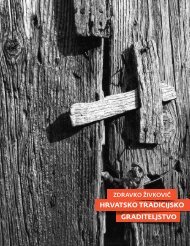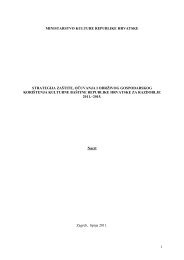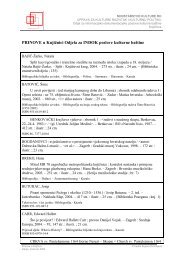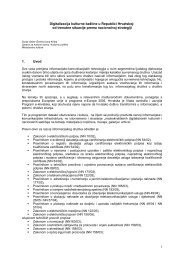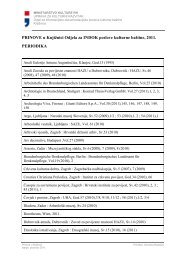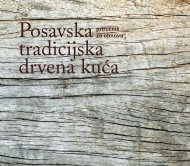Gašpina mlinica u Solinu - Ministarstvo kulture RH
Gašpina mlinica u Solinu - Ministarstvo kulture RH
Gašpina mlinica u Solinu - Ministarstvo kulture RH
Create successful ePaper yourself
Turn your PDF publications into a flip-book with our unique Google optimized e-Paper software.
186 | Godišnjak zaštite spomenika <strong>kulture</strong> Hrvatske 33/34-2009./2010.<br />
22 Konzola s vegetabilom dekoracijom (dokumentacija Arheološkog<br />
odjela Muzeja Međimurja Čakovec)<br />
Console with floral decoration (documentation of the Archaeological<br />
Department of the Museum of Međimurje Čakovec)<br />
Literatura<br />
Balog, Z. ( 2004.): Lepoglavsko-ptujskogorska grupa i uloga<br />
Hermanna Celjskog u difuziji parlerijanske gotike u Hrvatskoj,<br />
Zbornik 1. kongresa hrvatskih povjesničara umjetnosti,<br />
Zagreb, 47-59<br />
Bedeković, J. (1752): Natale solum magni ecclesiae doctris sancti<br />
Hieronymi (in ruderibus Stridonis occultatum, probatorum nihilominus<br />
historicorum, et geographicorum opinionibus, ac brevis<br />
Summary<br />
PROTECTIVE ARCHAEOLOGICAL RESEARCH<br />
CARRIED OUT FROM 1953 TO 1955 AT THE SITE OF<br />
THE DEMOLISHED CHURCH OF ST MIHOVIL<br />
THE ARCHANGEL IN MIHOVLJAN NEAR ČAKOVEC<br />
The church was originally a Gothic building that was partitioned<br />
and expanded on a number of occasions. It was the parish church<br />
of the city of Čakovec and after the abolition of the parish in 1789 it<br />
began to slowly deteriorate until it was demolished, most probably<br />
in the mid 19th century. The building materials were dispersed in<br />
the subsequent decades and used as secondary material in the<br />
construction of surrounding houses. In the immediate vicinity of<br />
the demolished church a brickyard began operating in 1884 which<br />
proved decisive for the remains of this structure. The archaeological<br />
research on the remains of the parish church of St Mihovil<br />
the Archangel in Mihovljan undertaken in the period from 1953<br />
to 1955 was the first known preventive archaeological research<br />
in the Međimurje region. The reason for initiating the research<br />
was the fact that the digging for the needs of the brickyard had<br />
almost reached the very foundations of the demolished church.<br />
Upon completing the research all the found structures were documented<br />
and their deconstruction began so that the gothic spolia<br />
could be extracted from them. Due to the application of such<br />
methodology in the course of the research, it is not possible today<br />
to reconstruct with certainty the layout of the building, however it<br />
illycanae chronologiae adjumento erutum atque cum vita ejusdem<br />
purpurati Dalmatae), Wiener Neustadt<br />
Buturac, J. (1984.): Popis župa zagrebačke biskupije 1334. i<br />
1501. godine, Starine JAZU LIX, Zagreb, 43-108<br />
Damiš, I. (1993.): O nestaloj crkvi sv. Mihovila u selu Mihovljan<br />
kod Čakovca, Marulić- Hrvatska književna revija 26/1993,5,<br />
Zagreb<br />
Damiš, I. (1994.): Iz prošlosti župe Čakovec, Zagreb<br />
Frančić, A. (2000.): Prvi spomen Međimurja, Kaj 1-2, Zagreb,<br />
61-70<br />
Horvat, A. (1956.): Spomenici arhitekture i likovnih umjetnosti<br />
u Međimurju, Zagreb<br />
Horvat, R. (1993.): Poviest Međimurja, Zagreb<br />
Ilijanić, M. (1956.): Muzej Međimurja u Čakovcu, Vijesti društva<br />
muzejsko-konzervatorskih radnika NR Hrvatske 1, Zagreb<br />
Ilijanić, M. (1957.): Iskapanja bivše čakovečke župne crkve u<br />
Mihovljanu, Muzeji- muzeološko-konzervatorski časopis 11-12<br />
1956-1957, Zagreb<br />
Kalšan, V. (2000.): Građansko društvo u Međimurju, Čakovec<br />
Kalšan, V. (2003.): Mihovljan 1203-2003, Čakovec<br />
Kapun, V. (2009.): Franjevci u Čakovcu, Čakovec<br />
Srša, I. (1994.): O međimurskim srednjovjekovnim župama i<br />
njihovim crkvama, Kaj 4-5, Zagreb<br />
Štefanac, S. (1997.): Gotska arhitektura v Prekmurju, Pokrajinski<br />
muzej Murska Sobota, Katalog stalne razstave, Murska<br />
Sobota, 71-78<br />
did succeed in preserving a large part of the stone material which<br />
primarily dates from the Gothic period. A detailed analysis of the<br />
material will most probably provide a clearer perception of the<br />
appearance of the building and its construction phases. On the<br />
research there is not much preserved documentation which makes<br />
it difficult to determine the structure and its dating while some<br />
facts on the appearance of the church can be found in the notes<br />
on cannon visitations by the Zagreb Diocese and in J. Bedeković<br />
book published in 1752. The protective archaeological research<br />
was the result of the timely reaction of the service for the protection<br />
of cultural heritage since the construction of the brickyard<br />
could have easily completely destroyed all the foundations of<br />
the building. The events from the 1950s are an example how a<br />
public interest, such as a cultural property can be sacrificed for<br />
another public interest which implies progress and development.<br />
The protective archaeological research undertaken in the 1950s<br />
on the site of the demolished church of St Mihovil the Archangel<br />
in Mihovljan was carried out only owing to the efforts of experts<br />
without which we would not have today any information on this<br />
valuable cultural property.



